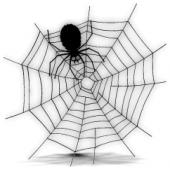 ew creatures are feared as much as spiders. There are over 3,000 different kinds of spiders in this country. Fortunately most of them can't penetrate our skin with their fangs. When they do bite people they either inject no venom or not enough to affect us. Keep in mind, spiders do not actively seek out people to bite.
ew creatures are feared as much as spiders. There are over 3,000 different kinds of spiders in this country. Fortunately most of them can't penetrate our skin with their fangs. When they do bite people they either inject no venom or not enough to affect us. Keep in mind, spiders do not actively seek out people to bite.
Pest Management Professionals
Copyright 2003-08. www.bugsorus.com
© Moore Consulting, 2007. All rights reserved. (News bulletins, various prevention tips, article contributions)
Serving Humboldt County for over 30 years




 Brown recluse spiders (and possibly hobo spiders) have a cytotoxic venom that can result in a necrotic (ulcerating) wound that is slow to heal. Bites from these spiders is much less common than it might seem. Recent research show that many people who think they have been bitten by this kind of spider have not been. There are other things that can cause a necrotic wound. They include bites from other pests, as well as conditions completely unrelated to pests, such as certain kinds of bacterial and fungal infections, gangrene, and ulcers from diabetes or bed sores.
Brown recluse spiders (and possibly hobo spiders) have a cytotoxic venom that can result in a necrotic (ulcerating) wound that is slow to heal. Bites from these spiders is much less common than it might seem. Recent research show that many people who think they have been bitten by this kind of spider have not been. There are other things that can cause a necrotic wound. They include bites from other pests, as well as conditions completely unrelated to pests, such as certain kinds of bacterial and fungal infections, gangrene, and ulcers from diabetes or bed sores.
 Recent evidence shows that the common yellow sac spiders, which many people believed caused necrotic wounds, don't cause those wounds at all; their toxin is neurotoxic.
Recent evidence shows that the common yellow sac spiders, which many people believed caused necrotic wounds, don't cause those wounds at all; their toxin is neurotoxic.
 We are the area experts at spider control. Keep in mind that reinfestations occur when young spiders catch a breeze and use it to "parachute" to your home on a silk strand. Also, some spiders are "hunting spiders" that don't wait for prey to come to them; these occasionally wander indoors.
We are the area experts at spider control. Keep in mind that reinfestations occur when young spiders catch a breeze and use it to "parachute" to your home on a silk strand. Also, some spiders are "hunting spiders" that don't wait for prey to come to them; these occasionally wander indoors.
 Nevertheless, there are two types of spider venom that sometimes cause a serious reaction. The black widow and it's cousins have a neurotoxic venom. This kind of venom can cause pain as well as muscle cramping, sweating, weakness, and breathing difficulties. Fortunately, fatalities are extremely rare.
Nevertheless, there are two types of spider venom that sometimes cause a serious reaction. The black widow and it's cousins have a neurotoxic venom. This kind of venom can cause pain as well as muscle cramping, sweating, weakness, and breathing difficulties. Fortunately, fatalities are extremely rare.







